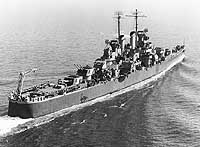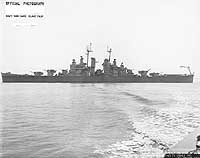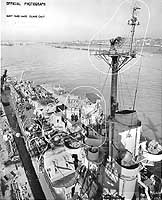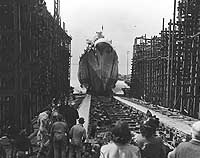Return to Naval Historical
Center home page.  Return to Online
Library listing
Return to Online
Library listing
DEPARTMENT OF THE NAVY -- NAVAL HISTORICAL CENTER
805 KIDDER BREESE SE -- WASHINGTON NAVY YARD
WASHINGTON DC 20374-5060

Online Library of Selected Images:
-- U.S. NAVY SHIPS --
USS Birmingham (CL-62), 1943-1959
USS Birmingham, a 10,000-ton Cleveland class
light cruiser, was built at Newport News, Virginia. She commissioned
in late January 1943 and, following shakedown, crossed the Atlantic
to the Mediterranean Sea where she supported the invasion of Sicily
during July 1943. Birmingham was sent to the Pacific in
August and escorted the fast carrier task forces during raids
on Tarawa and Wake over the next two months. On 8 November 1943,
while participating in the Bougainville operation, she was hit
forward by a Japanese aerial torpedo and aft by two bombs, but
was able to remain in formation until detached to return to the
United States for repairs.
Back in fighting trim in February 1944, Birmingham's
next major undertaking was the invasion of the Marianas in June
and July. She screened the landing forces and provided extensive
gunfire support as troops ashore gradually overwhelmed the Japanese
defenders of Saipan, Tinian and Guam. In mid-June, as the enemy
responded to the Saipan landings by sending out his Mobile Fleet,
Birmingham helped protect U.S. aircraft carriers during
the Battle of the Philippine Sea. She continued in the carriers'
screen later in the year, during the September-October raids on
the Philippines, Okinawa and Formosa. On 24 October 1944, on the
first day of the Battle of Leyte Gulf, she suffered heavy casualties
and serious topside damage when the burning carrier Princeton
(CVL-23) blew up while Birmingham was alongside assisting
with firefighting.
In March-May 1945, the newly-repaired Birmingham took
part in the Iwo Jima and Okinawa campaigns. During Japanese Kamikaze
attacks on ships off Okinawa on 4 May, she was again damaged,
suffering more than fifty crewmen killed and many others injured
when a suicide plane crashed into her deck just aft of the forward
gun turrets. More shipyard work returned her to the western Pacific
in late August 1945, soon after Japan had agreed to surrender.
She remained in the area for some months, visiting Brisbane, Australia,
in November. The cruiser steamed to San Francisco, California,
in March 1946 and was decommissioned there at the beginning of
January 1947. Stricken from the Naval Vessel Register in May 1959,
after a dozen years in "mothballs", USS Birmingham
was sold for scrapping the following November.
This page features selected views related to USS Birmingham
(CL-62), and provides links to pictures of her actions and activities.
For other images related to this ship, see:
USS Birmingham (CL-62) --
Actions and Activities.
Click on the small photograph to prompt
a larger view of the same image.
Photo #: NH 98120
USS Birmingham (CL-62)
Underway in the Hampton Roads area, Virginia, on 20 February
1943.
This image has been retouched by wartime censors to obscure radar
antennas atop the ship's gun directors.
Official U.S. Navy Photograph, from the Collections of the
Naval Historical Center.
Online Image: 90KB; 740 x 595 pixels |
 |
Photo #: NH 90021
USS Birmingham (CL-62)
Underway in the Hampton Roads area, Virginia, on 20 February
1943.
Photographed by Naval Air Station, Hampton Roads.
Courtesy of the U.S. Naval Institute. James C. Fahey Collection.
U.S. Naval Historical Center Photograph.
Online Image: 119KB; 740 x 570 pixels |
 |
Photo #: NH 87948
USS Birmingham (CL-62)
Off the Mare Island Navy Yard, California, following overhaul
and repair of combat damage, 21 January 1945.
Official U.S. Navy Photograph, from the Collections of the
Naval Historical Center.
Online Image: 72KB; 740 x 610 pixels |
 |
Photo #: NH 87950
USS Birmingham (CL-62)
Off the Mare Island Navy Yard, California, following overhaul
and repair of combat damage, 21 January 1945.
Official U.S. Navy Photograph, from the Collections of the
Naval Historical Center.
Online Image: 93KB; 740 x 610 pixels |
 |
Photo #: NH 98122
USS Birmingham (CL-62)
At the Mare Island Navy Yard, 22 January 1945, following battle
damage repair and overhaul.
Photographed from one of the Navy Yard cranes, this "plan
view" of the ship's forward area shows a number of recent
alterations, enclosed in white lines drawn on the image.
Notable features include the forward Mark 37 Gun Director with
antennas for Mark 12 and Mark 22 radars (upper left center);
6"/47, 5"/38, 40mm and 20mm guns; protective canvas
covers on 40mm gun barrels; and a variety of equipment on the
ship's command platform.
Also note the portable gangway between the ship and the pier,
and very long shadows cast by people standing on the pier.
Official U.S. Navy Photograph, from the Collections of the
Naval Historical Center.
Online Image: 169KB; 600 x 765 pixels |
 |
Photo #: NH 98123
USS Birmingham (CL-62)
At the Mare Island Navy Yard, 22 January 1945, following battle
damage repair and overhaul.
Photographed from a Navy Yard crane, this "plan view"
of the ship's midships area shows a number of recent alterations,
enclosed in white lines drawn on the image.
Notable features include Mark 34 Gun Directors with antennas
for Mark 8 radar on top; height-finding radar on the mainmast;
antenna for SK search radar on the foremast; and new electronic
antennas on the after end of the forward smokestack.
Official U.S. Navy Photograph, from the Collections of the
Naval Historical Center.
Online Image: 147KB; 740 x 615 pixels |
 |
Photo #: NH 98124
USS Birmingham (CL-62)
At the Mare Island Navy Yard, 22 January 1945, following battle
damage repair and overhaul.
Photographed from a Navy Yard crane, this "plan view"
of the ship's midships area shows a number of recent alterations,
enclosed in white lines drawn on the image.
Notable features include the forward smokestack, with a new electronics
platform mounted on it; 40mm quad gun mounts; life rafts; Mark
34 Gun Director; and a variety of equipment on the ship's forward
superstructure platforms.
Official U.S. Navy Photograph, from the Collections of the
Naval Historical Center.
Online Image: 174KB; 740 x 610 pixels |
 |
Photo #: NH 98125
USS Birmingham (CL-62)
At the Mare Island Navy Yard, 22 January 1945, following battle
damage repair and overhaul.
Photographed from a Navy Yard crane, this "plan view"
of the ship's after area shows a number of recent alterations,
enclosed in white lines drawn on the image.
Notable features include a Mark 34 Gun Director with antenna
for Mark 8 radar; Mark 37 Gun Director with antennas for Mark
12 and Mark 22 radars; the after smokestack with searchlight
platforms mounted on it; and the height-finding radar and other
electronic equipment on the mainmast.
Official U.S. Navy Photograph, from the Collections of the
Naval Historical Center.
Online Image: 144KB; 600 x 765 pixels |
 |
Photo #: NH 75592
USS Birmingham (CL-62)
Launching, at the Newport News Shipbuilding and Dry Dock Company
shipyard, Newport News, Virginia, 20 March 1942.
Courtesy of James Russell, 1972.
U.S. Naval Historical Center Photograph.
Online Image: 108KB; 740 x 610 pixels |
 |
Photo #: NH 89291
USS Birmingham (CL-62)
View on the cruiser's forecastle, looking aft, taken the day
she left the San Diego Reserve Fleet facility for the wrecking
yard, circa 9 December 1959.
Courtesy of the U.S. Naval Institute Photo Collection, 1979.
U.S. Naval Historical Center Photograph.
Online Image: 87KB; 595 x 765 pixels |
 |
For other images related to this ship, see:
USS Birmingham (CL-62) --
Actions and Activities.
 Return to Naval
Historical Center home page.
Return to Naval
Historical Center home page.
Page made 22 October 2002
